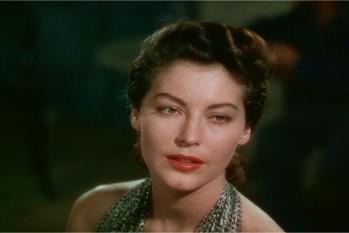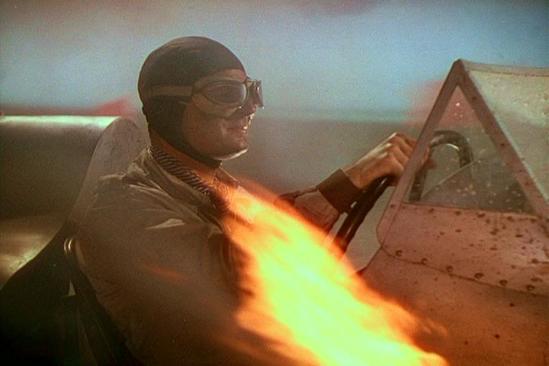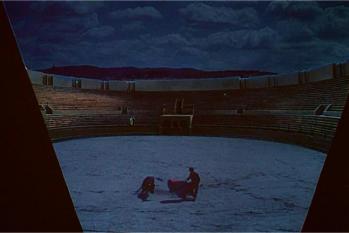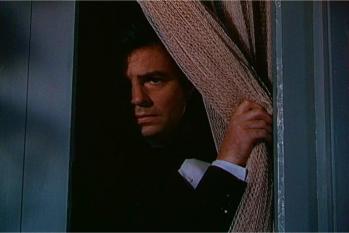§§ 1930. The fishing village of Esperanza on the Mediterranean coast of Spain. An American nightclub singer is hanging out with a group of English friends -- an archaeologist and his niece, a drunken poet, and a racing car driver who is about to attempt a new land speed record on the flat sand beach nearby. The singer, a femme fatale who has come here from London with the poet, is a beautiful bitch who suffers from a love hangover or more accurately too much attention from all the wrong lovers. In short, the men just don't measure up.
And just why is she here on the gypsy coast? Is she drifting into an unwise marriage through boredom or is she here for a unknown, fatal rendezvous? Once again, it's the lost generation playing in a lost land. There's something unreal about Esperanza, as if it exists between now and then in a twilight of broken statues and mythological memory. The characters are from the modern, industrialized world, but Esperanza with its gypsy culture and primitive instinct is like a neo-classical garden replete with follies and supernatural possibility. And what stitches the distant past to the existential present? Why, the legend of the Flying Dutchman.
Pandora & The Flying Dutchman (1951) is a peculiar yet fascinating mix of modern art and romantic mysticism. Its pedigree is film noir -- i.e. the femme fatale and the extensive use of night shadow cinematography -- although the story is literary with its European setting and extensive symbolism. Pandora Reynolds (Ava Gardner) is a reset of Hemingway's Lady Brett -- pure sensuality in a non-intellectual body (Ava Gardner said that she had no idea what the film was about, even after playing her character to the finish), a refugee from the clubs of New York and London as a goddess of urban noir. Her phantom lover, Hendrik van der Zee (James Mason), is an intellectual of no fixed address, arrives in a crewless yacht dressed in mystery. He paints, he writes, he reads... but where his money comes from is never part of the conversation. He's the anti-thesis of the film noir hard male protagonist, comes directly from the desperate heroes of Romantic literature. He doesn't need a knife or a gun because, like H.G. Wells' Time Traveller, he gets around, regardless.

the geometrical hinges of death
Evening. Las Dos Tortugas (the Two Turtles), a bodega/cafe on the beach. Pandora is there with her friends, smoking and drinking. A flamenco ensemble performs.
The flamenco interlude might seem to be just a bit of location atmosphere, yet it is more than this. A male dancer takes the floor, then the woman, and then another male, and both males circle the woman. Just as in a stage play where symbolism is used by necessity when verbal exposition won't do, the competition for the woman's attention mirrors exactly the situation at the start of the story. Pandora has two suitors -- Reggie Demarest, the alcoholic poet, now on the way out... and Stephen Cameron, the racing car driver, her latest lover. All that is missing from this Lorca-esque routine is the fourth dancer, Death.
After the flamenco performance, she goes to the piano, sings a slow club song, the sort of piano teaser popular for the period. Reggie leans against the upright, pissed and besotted; he thinks this party is a celebration of their anniversary since meeting in London one year ago and when Pandora finishes, he proposes. Her dismissal isn't so much a rejection as it is a deferral. Anything a drunk says can't be serious. However, he is serious; he spikes his drink with some fatal powder, smiles, downs it all, staggers towards the table where their friends sit, has one final poetic declaration:
Reggie: I know Death has 10,000 special doors for men to make their exits... and they move on such strange geometrical hinges you may open them both ways... and anyway's fine out of your whispering....
He then falls dead in a theatrical flourish. Some gesture, some anniversary.
Again, you might think his final words are mere effect, yet their imagery -- a direct lift from Webster's play, The Duchess of Malfi -- fits perfectly with the mystical intent of the story and its surrealist patina. As Geoffrey Fielding recalls, "The moon was at the full, erotic and disturbing." Indeed.
Pandora: in Greek mythology, the first woman. Created by Zeus to punish Man after Prometheus had created the human race (Man). She came with a box or jar in which all sorts of evils and diseases were stored. Bad news woman, and this "Pandora" is no exception. Despite the fact that they should know better, a procession of men compete for her as if she is a mystic trophy in disguise: a poem, a racing car, a bull, or even Jesus Christ. She is a pure sexual lure, a modernist siren who responds to her lovers' sacrifices with the diffidence of a gentle sociopath. Her cool response to Reggie's death seems baffling, or even appalling, yet the speed of the narrative shift doesn't allow much ethical deliberation. I'm a bitch, therefore I am. Janet -- her rival for Stephen Cameron's affections -- attempts to call her on it, yet Janet merely comes across as a jealous hysteric.



